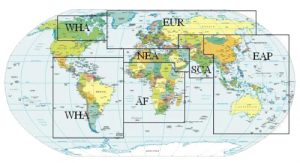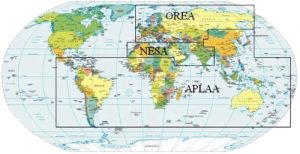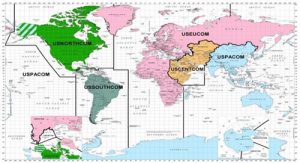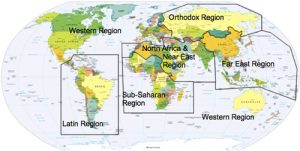The Need for a Common Interagency Regional Framework
by Matthew Puglisi, Jason Hanover, Phil Purcell, Kathleen List
Military officers and a State Department faculty member at the Joint Forces Staff College in Norfolk, VA, discuss the difficulties of interagency coordination in American foreign policy and national security operations and highlight the very basic problem of the differing regional frameworks and corresponding bureaucracies into which the State and Defense Departments and the CIA organize the world. They propose a common frame of reference based on geopolitical and other important factors, and steps for moving toward it, beginning with Sub-Saharan Africa. — Ed .
“The most urgent task of our government is getting interagency coordination & cooperation right. The interagency process was largely a failure prior to September 11, 2001, but has only marginally improved since that time in effecting successful planning and action for accomplishing specific U.S. policy objectives overseas.”1
— Ambassador William Bellamy, Senior Vice President, National Defense University
To enable increased interagency cooperation and synergy, U.S. governmental agencies must align regional areas of responsibility based on a common geopolitical, demographic, economic, infrastructural, and environmental frame of reference in order to enhance the flow of information and increase the unity of effort. Subsequent to the release of the Goldwater-Nichols Department of Defense (DOD) Reorganization Act of 1986 and mission execution during Operation DESERT STORM, the U.S. government successfully addressed problems inherent in joint military operations. Unfortunately, September 11, 2001, highlighted the need for an interagency transformation of the same magnitude that the joint military world went through ten years earlier. Interagency initiatives, although founded on laudable principles, will remain ineffective unless the entire interagency community realigns its regions to one common operating picture. While the recommended realignment will not in itself solve the interagency problem set, it will provide a solid foundation, that first step, to support current and future improvement initiatives.
This essay will first provide a background on how different agencies, representing different aspects of the national instruments of power — Diplomacy, Information, Military, Economic (DIME) — currently divide the globe. The argument will then be built defending the need for common divisions, and finally, a methodology and recommended implementation plan will be proposed.
Background
Although United States’ strategic interests dictate a coordinated global engagement plan, the U.S. government (USG) agencies most actively employing our instruments of power do not share a common global viewpoint. In an effort to maximize effectiveness, each USG agency responsible for projecting our national power on the international stage has developed a global regional framework to facilitate its ability to focus its powerbase, and coordinate its community’s efforts to achieve objectives in each area of responsibility (AOR). For this paper we will discuss Department of State (diplomatic, economic), Central Intelligence Agency (information), and Department of Defense (military) regional alignments, as they are three of the most heavily engaged agencies in projecting our instruments of power abroad. While DIME is most effective when employed in whole, each of these agencies has established an autonomous regional framework, and subsequent regional engagement plan, to guide its organization’s international efforts.
Within the executive branch, the Department of State (DOS) is the lead U.S. foreign affairs agency responsible for advancing American objectives and interests by developing and implementing the administration’s foreign policy. Since NSPD-44 created the Office of the Coordinator for Reconstruction and Stabilization, DOS additionally has the primary role in establishing policy, priorities, and goals for post conflict efforts.2 To accomplish its mission, DOS maintains diplomatic and consular posts around the world, with six regional bureaus to coordinate their efforts. The Bureau of European and Eurasian Affairs (EUR) encompasses Europe and Russia. The Bureau of Near Eastern Affairs (NEA) is responsible for North Africa and the Middle East. The Bureau of African Affairs (AF) deals with sub-Saharan countries. The Bureau of South and Central Asia (SCA) includes the countries falling geographically between Kazakhstan and Sri Lanka to include India, Pakistan, and Afghanistan. The Bureau of East Asian and Pacific Affairs (EAP) covers the Pacific Rim countries from China to New Zealand, and The Bureau of Western Hemisphere Affairs (WHA) is responsible for Central and South America, the Caribbean, and Canada (Map 1). The Assistant Secretaries of each geographic bureau advise the State Department’s Under Secretary and guide the diplomatic efforts within their respective region.3 DOS also has functional bureaus that effect transnational operations.

Map 1. DOS Regional Bureaus.
The Central Intelligence Agency (CIA), now a member of the U.S. Directorate of National Intelligence, is a key provider of international information collection, analysis, and distribution. Within the CIA, the Directorate of Intelligence is responsible for studying the political, economic, leadership, societal, and military developments of each country around the world. Like DOS, CIA uses a regional structure to divide its priority international/country operations into regions; however, it only uses three regionally-oriented offices covering the non- U.S. portions of the globe. The Office of Russian and European Analysis (OREA) provides intelligence support on Europe, Russia, and the Balkan countries. The Office of Near Eastern and South Asian Analysis (NESA) provides analytical support on Middle Eastern and North African countries, plus the South Asian countries of India, Pakistan, and Afghanistan. Finally, The Office of Asian Pacific, Latin America, and African Analysis (APLAA) covers the remainder of the non-U.S. portions of the globe (Map 2).4

Map 2. CIA Regional Offices.
The U.S. DOD, America’s military instrument of power, is divided into Unified Combatant Commands (COCOM) to provide unity of effort. A COCOM has a broad, continuing mission under a single commander and is composed of forces from two or more military departments organized on a geographic or functional basis. Each regional combatant commander is assigned an AOR by the Unified Command Plan (UCP), where they are responsible for all operations within their designated areas. There are five geographically designated combatant commands. U.S. Northern Command (USNORTHCOM) is responsible for the United States, Canada, and portions of the Caribbean and Latin America. U.S. European Command (USEUCOM) encompasses Europe, Russia, and Africa except for the Horn. U.S. Central Command (USCENTCOM) covers the Middle East, the Horn of Africa, and the countries between Pakistan and Kazakhstan. U.S. Pacific Command (USPACOM) is made up of China, India, Antarctica, and all the Pacific Rim countries to include Hawaii and Alaska (Alaska is also part of USNORTHCOM). Finally, U.S. Southern Command (USSOUTHCOM) is responsible for South America and the remainder of the Caribbean and Latin America (Map 3).5 DOD is currently standing up a sixth geographic command, U.S. Africa Command (USAFRICOM), to focus efforts in this troubled area. This Unified Combatant Command would cover all of Africa, except for Egypt. Our proposal would leave the Muslim North African countries and the Horn of Africa in USCENTCOM.6

Map 3. Unified Combatant Commands.
Analysis
In order to fix current shortfalls and realize the greatest improvement in interagency coordination, DOS, CIA, and DOD must adopt common regional divisions to provide a common frame of reference. According to the Chairman, Joint Chiefs of Staff, General Peter Pace, “The real benefit to the American people will come after various groups of government employees work together, get to know each other, and begin to trust employees in other agencies.”7 The Chairman is keenly aware that the twenty-first century environment calls for greater unity of effort among USG departments and agencies to synchronize the national elements of power, and effectively plan, coordinate, and execute operations, or respond to a crisis. Where, then, do we currently fall short?
While existing regional divisions may meet individual agency needs, lack of uniformity results in failed coordination. Duplication of effort in a time when budgets, and therefore resources, are shrinking severely hinders efficient and timely work. Under the current structure, this duplication regularly occurs as is evidenced by the ongoing Operation Iraqi Freedom reconstruction where both DOS and DOD worked on separate postwar plans in different locations, with little to no coordination. In another example, an article in the Washington Post highlighted the fact that, “In the lead up to the Turin, Italy, Olympics, eight of the sixteen intelligence agencies produced assessments to the games. The finished intelligence products, a CT official said, all concluded exactly the same thing — that the threat was minimal.”8 Another shortfall is highlighted when looking at regional engagement planning. Currently, each agency authors its own plan with little coordination. Other agencies applying instruments of power are rarely consulted because the different regional boundaries result in different controlling problem sets. For example, when DOS Bureau of Near East Affairs drafts a regional plan, in order to coordinate it with DOD it would have to engage with both CENTCOM (for the Middle Eastern nations) and EUCOM (for the North African nations) for their inputs. Not only is this burdensome, but neither CENTCOM nor EUCOM has the same overall picture as State NEA because they each only have a piece of the problem set.
Effective regional engagement is built from a common understanding of a myriad of complex factors that thread through country borders, and intermingle across the entire region. One country can impact all those around it, so it follows that if the countries within regions differ, the problem sets will differ as well.
Finally, for each of the instruments of power, there is more than one agency that plays a role. If those agencies do not have a common focus, how can they possibly coordinate effectively? Digging into the “information” instrument of power and using the “intelligence” aspect of information, this point quickly emerges. There are 16 different agencies in the intelligence community. CIA, DOD, and DOS all have primary roles in this arena, as well as the Federal Bureau of Investigation, Treasury, Energy, etc. Each looks at a given problem set from a community-centric perspective; however, a complete picture can require information from multiple agency sources. If the CIA agent following intelligence threads in his area of responsibility needs to coordinate with DOD or DOS, he may be required to contact multiple commands and/or bureaus. The single most important concept within intelligence is to eliminate the gaps and seams in information collection, but with the multiple regional boundaries in play, multiplied by the number of agencies involved, seams are actually increased, leading to “intelligence failures.”
The problems previously discussed were all highlighted in the 9/11 Commission Report, used today as the driving force behind interagency reform. To set the proper foundation for effective change, agencies need a common view of the world.
By adopting common regional divisions, interagency barriers will be broken down and synergy at the strategic, operational, and tactical levels will be facilitated. If everyone involved in implementing U.S. policy overseas divided the globe the same way, an interagency team would likely evolve out of a natural progression of events. Habitual relationships will form between staffs that are attending the same meetings and conferences; familiar faces will cross paths when working the same “hot issues.” In a world where name and face recognition go a long way towards establishing credibility, traditional interagency barriers will break down simply because, “I know him, I’ve worked with him before and he’s a good guy.” As different staffs with different missions begin to intermingle because of these established relationships, their interaction will lead to an understanding of where other agencies fit into U.S. policy execution, where their strengths are, and when to draw on their expertise. With this solid foundation laid, duplication of effort will lessen and communication will flow more smoothly simply because staffs know where to go for what. Regional coordination will not cross bureau or command boundaries (although functional bureaus and commands will) and seams will begin to disappear.
At this point, the U.S. government will be ready to properly and successfully implement all the transformation initiatives that are currently floundering because of poor interagency infrastructure. The key to successful transformation is the proper division of the world.
Recommendations
If DOS, CIA, and DOD divide the globe into regions based on prevailing geopolitical, demographic, economic, infrastructure, and environmental factors, engagement across the instruments of power will be better coordinated and synergized. Analyzing these variables makes it possible to group nations with similar trends, and therefore similar problem sets, to ensure that interagency participants with regional engagement plans can more easily leverage all instruments of national power in support of our national strategic objectives.
Geopolitics, demographics, economics, technological development, and environmental factors give social and political scientists insight into underlying causes of national, regional, and global conflict. Analyzing the existing distribution of power, and forecasting the future evolution of that distribution of power among nation-states, gives a part of the geopolitical picture. But to fully explore this topic, non-state actors at the inter- and intra-state level must be considered. This will provide insight into who the regional power players are, what their agendas are, and how they wield their power over others. Studying demographics provides deep insight into the social and cultural issues that shape politics and policies, and can ultimately lead to conflict when not understood.
In particular, tribal boundaries, religious boundaries, fertility rates, urbanization trends and cross border refugee trends all lead to strains on national and regional stability if negative trends are not countered by the national or international community. While demographic and economic variables overlap quite a bit, it is also critical to understand other economic factors such as: level of infrastructure, natural resources, foreign direct investment, and stability of local currencies. A related topic, technological development, provides insight into the ability of a nation or region to merge with the global economy, in particular the infusion of information technology (currently), biotechnology (in the near future), and alternative energies (in the more distant future). Finally, environmental factors such as fresh water scarcity, soil depletion, and deforestation play a role not just as indicators of future roadblocks to prosperity but also as indicators of industrial and agricultural development, by suggesting how those roadblocks are being remedied.9 Once these factors are laid out, and the results applied across the globe, groupings of common results begin to emerge.
Based on the recommended analysis, USG agencies should divide the globe into six somewhat homogenous groupings: Western Region, Orthodox Region, North Africa & Near East Region, Far East Region, Latin Region, and the Sub-Saharan Region.10

Map 4. Recommended Regions.
The make-up of the regions, and the driving variables that define them, are as follows:
- The Western Region is comprised of North America, Western Europe, and the European settler countries like Australia and New Zealand. Its core geopolitical power is the United States, but there are regional challenges to this dominance, especially as the European Union (EU) grows. Christianity and low fertility rates are the core demographic trend. It is the most stable region economically, leads the world in technological integration and the information age, and is well on the way toward mitigating environmental shortfalls that industrialization created.
- The Orthodox Region, with Russia as the geopolitical core, is comprised of Eastern Europe and the orthodox former Soviet republics. Non-state actors such as the Russian Mafia, ethnic diasporas like Chechnya, and of course militant Islamic fundamentalists threaten them. With the fall of the USSR, the region opened up to industrialization and the common side effects of that progress such as low fertility rates, high abortion rates, and falling life expectancy rates. This changes the national security paradigms of these nations to a more technological force versus a larger force. The inability to protect borders from a purely numeric standpoint could result in this region seeing an increase in WMD research and production. Finally, there could be conflict over sources of fresh water (between Uzbekistan and Kyrgyzstan) as well as deforestation and soil depletion (Ukraine).11
- The Near East Region is comprised of the Muslim Middle East through India as well as Muslim North Africa. The key characteristic of this region is the leadership changes (most notably Iran, Jordan, Morocco, Bahrain, and Iraq), and how they tie into the increasing non-state aggression from transnational and subnational fundamentalist groups. Added to this is the demographic tinderbox of high fertility rates, young population bulge, urbanization, mixed ethnic settlements causing huge diasporas, fluctuating oil prices affecting economic well being, and shortages of fresh water throughout the region. This kind of environment leads to shortages of housing and land, underemployment, strained infrastructure, and pollution. A small spark can set off spontaneous violence that can lead to revolution, civil war, regional conflict and even global war.12
- The Far East Region centers around China. It is comprised of the traditional Asian-Pacific rim countries. Geopolitically, this region provides the most diverse problem set in that it has an emerging superpower at its core with a political ideology not embraced by many, leading possibly to communist insurgencies. A very diverse religious population adds non-state pressure on national governments, thus further defining the complex “power struggle” within the region. Technological development is extremely diverse from one area to the next, and economic prosperity tends to follow technology in this region. Pollution is a factor in the industrialized countries.
- The Latin Region covers South and Central America as well as the Caribbean islands. It is characterized by movement towards popular socialist rule and destabilized by weak conventional militaries with largely underdeveloped navies and air forces, transnational terrorist groups, drug cartels, organized crime, and right-wing militias. The extreme inequality, poverty, and concentration of wealth, income, power, and opportunity provides sources of friction. While the overall technological level in the region is low, its access to natural resources is reshaping relations. New roads being built across the Andes will link the Atlantic and Pacific Oceans for truck and rail traffic, and in turn open land for agricultural production and opportunities for the poor to escape poverty. In that process, jobs, new living spaces and new economic opportunities will be created throughout the region; however, its environmental impact remains controversial and its effect on wealth distribution to the middle and lower classes questionable.
- The Sub-Saharan Region is defined as the African Continent not within the definition of the Near East. Abundant ungoverned areas, and a lack of rule-of-law, political stability, and accountability in government, have increased its vulnerability and receptivity to terrorist safe-havens. This region contains many of the world’s poorest countries. Average income per capita is lower today than at the end of the 1960s. Income, assets, and access to essential services are unequally distributed. The region also contains a growing share of the world’s absolute poor, who have little power to influence the allocation of resources. The HIV/AIDS pandemic is continuing to widen and deepen with rates remaining above 8% in many African countries, and reaching nearly 33% in Zimbabwe and 38% in Botswana and Swaziland. Agriculture is the mainstay of most sub-Saharan economies, but productivity has stagnated over the past five years, and per capita food production has declined to 1980 levels. The most significant constraints to increasing agricultural productivity include low usage of improved technologies and information, under-capitalization of farmers, poor land use and poor infrastructure.13
Perhaps the hardest step in this recommended restructuring is the process to implement change. Although regional alignment is critical to solving interagency coordination problems, large sweeping changes will meet with staunch resistance, and only a methodical effort to evolve can assure success in this endeavor. Currently, DOD is standing up USAFRICOM, a new major command responsible for the continent of Africa (minus Egypt). If the recommendations of this paper were implemented, however, step one would create an Africa Command (AFCOM) made up of sub-Saharan African nations, with the North African Muslim countries shifting in responsibility to CENTCOM (as depicted in Map 4). Step two would require the CIA to break an “Office of African Analysis” out of their current Office of Asian Pacific, Latin America, and African Analysis. Since DOS’s Bureau of African Affairs is already aligned with a sub-Saharan responsibility, a common regional view across the instruments of power would be achieved. Sub-Saharan Africa would then serve as the implementation template of the common regional framework plan, sowing the seeds for future interagency success.
Conclusion
The need for increased interaction and unity of effort is clearly evident in U.S. global strategic interests, and each agency must have the ability to communicate, organize, plan, and execute in concert to synergize effort. In the “do more with less” era, we cannot afford to duplicate effort or, even worse, execute conflicting theater engagement plans. To set the stage for future interagency success, U.S. government agencies must align regional areas of responsibility.![]()
END NOTES
1. Ambassador William Bellamy, Introductory remarks at the Interagency Coordination Symposium, Washington, D.C.: National Defense University, September 12, 2006.
2. President, “National Security Presidential Directive/NSPD-44,” December 7, 2005
3. “US Department of State, Organization,” http://www.state.gov/r/pa/ei/rls/dos/436.htm, accessed on September 20, 2006
4. “Directorate of Intelligence, Organization,”https://www.cia.gov/cia/di/organization.html, accessed on September 20, 2006
5. “Unified Combatant Command,” http://en.wikipedia.org/wiki/Unified_Combatant_Command, accessed on September 20, 2006
6. Gordon Lubold, “DOD Eyes Adding Africa as Combatant Command,” Air Force Times, Vol. 67, No. 8, September 11, 2006, pp. 29.
7. Jim Garmone, “Discussions Needed to Change Interagency Process, Pace says,” American Forces Press Service, September 17, 2004, pp1
8. Karen DeeYoung, Washington Post, “A fight against Terrorism-and Disorganization,” August 9, 2006, pp A6
9. Brian Nichiporuk, Alternative Futures and Army Force Planning, Santa Monica, CA: RAND Corporation, 2001, pp 15-35.
10. Samuel P. Huntington, The Clash of Civilizations and the Remaking of the New World Order. New York, NY: Simon and Schuster, 2003, pp 26-27.
11. David Adamson and Laurent Murawiec, Demography and Security, Paris, France: RAND Corporation, 2001, pp 9-11.
12. Brian Nichiporuk, Security Implications of Demographic Factors in the Middle East, Santa Monica, CA: RAND Corporation, 2001, pp 12-13.
13. World Bank, “Can Africa Claim the 21st Century,” March 30, 2000; http://web.worldbank.org , accessed on 23 October, 2006.
Lt. Col. Phil Purcell is an Instructor Pilot in the Virginia Air National Guard. Dr. Kathleen List is a Foreign Service Officer currently serving as the State Department Chair at the Joint Forces Staff College. Maj. Jason Hanover, USAF, is an Instructor Pilot assigned to the Joint Special Operations Command, Ft. Bragg, NC. Maj. Matthew Puglisi, USMC, assigned to the U.S. Pacific Command Special Operations Branch. This article was originally a prize-winning paper for the Joint and Combined Warfighting School course at the Joint Forces Staff College.
